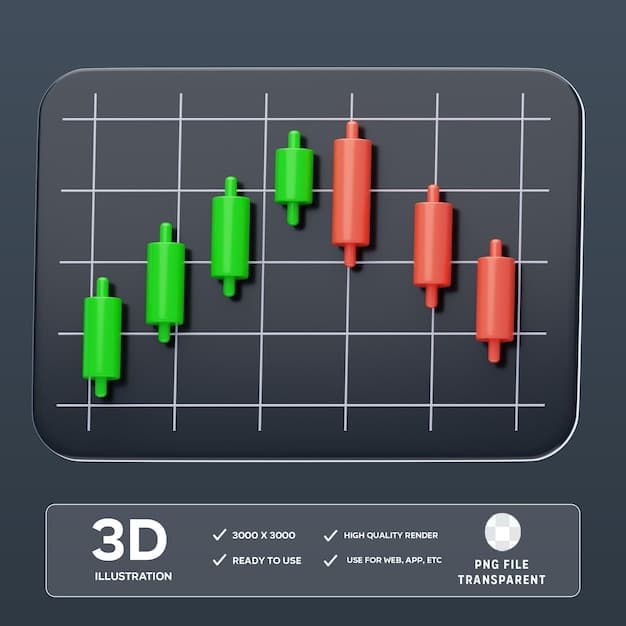Mastering Swing Trading: A Step-by-Step Guide for US Investors

Mastering the art of swing trading involves understanding market trends, utilizing technical analysis, and implementing risk management strategies to capitalize on short-term price fluctuations, making it a potentially profitable venture for US investors.
Are you a US investor eager to navigate the exciting world of swing trading? Mastering the art of swing trading: a step-by-step guide for US investors provides the insights and strategies you need to potentially profit from short-term market movements.
What is Swing Trading and Is It Right for You?
Swing trading is a trading strategy that aims to profit from price swings in the market over a few days or weeks. It’s a short-term trading style that sits between day trading and long-term investing.
Before diving in, it’s crucial to assess whether swing trading aligns with your risk tolerance, capital availability, and time commitment.
Key Characteristics of Swing Trading
Swing trading involves holding positions for more than a single day, exposing traders to overnight and weekend risks.
- Time Commitment: Requires daily market monitoring and analysis.
- Risk Tolerance: Involves higher risk than long-term investing, but potentially lower than day trading.
- Capital Requirements: Sufficient capital to withstand potential losses and margin requirements.

Swing trading may be suitable if you are comfortable with taking on more risk for potential higher returns and have the time to dedicate to learning and applying technical analysis techniques. If you prefer a hands-off approach or are risk-averse, other investment strategies might be a better fit.
In conclusion, swing trading is a technique where you hold stocks for multiple days to profit on price “swings”. It is an active trading style that requires time, knowledge, and money.
Setting Up Your Swing Trading Account
Choosing the right brokerage account is a foundational step in your swing trading journey. Consider factors such as commissions, platform features, research tools, and margin rates.
Ensure that the brokerage you choose offers access to the US stock market and provides the necessary tools for technical analysis and order execution.
Key Brokerage Features for Swing Traders
A good brokerage platform should provide real-time data, advanced charting tools, and support for various order types.
- Low Commissions: Minimizes trading costs, especially important for frequent traders.
- Advanced Charting: Essential for identifying trends and patterns.
- Real-Time Data: Ensures timely decision-making.
Once you’ve selected a brokerage, familiarize yourself with its platform and trading tools through paper trading or simulated accounts. Practice executing trades, setting stop-loss orders, and managing your positions before risking real capital.
In conclusion, choosing the right brokerage account is essential for the swing trader, and you would be best served by doing extensive research before making this decision.
Mastering Technical Analysis for Swing Trading
Technical analysis is a cornerstone of swing trading. It involves analyzing historical price and volume data to identify potential trading opportunities.
Swing traders use various technical indicators and chart patterns to identify entry and exit points.
Popular Technical Indicators
Several indicators are commonly used in swing trading. Knowing how to implement them efficiently is key to your success.
- Moving Averages: Smoothens price data to identify trends.
- Relative Strength Index (RSI): Measures the magnitude of recent price changes to evaluate overbought or oversold conditions.
- Moving Average Convergence Divergence (MACD): Identifies changes in the strength, direction, momentum, and duration of a trend in a stock’s price.

In addition to indicators, chart patterns such as head and shoulders, double tops, and triangles can provide valuable insights into potential price movements. Combine indicators with chart patterns to increase the probability of successful trades. Always remember that there are no certainties in stock trading.
To conclude, technical analysis is vital for swing trading, but it is not the only required skill; traders also need a feel for the market and a stomach for risk.
Developing a Swing Trading Strategy
A well-defined trading strategy is essential for consistent success in swing trading. It outlines the rules and criteria for identifying potential trades, managing risk, and taking profits.
Your strategy should align with your risk tolerance, capital, and time commitment.
Key Components of a Swing Trading Strategy
An effective trading strategy provides clear guidelines for trading decisions.
- Entry Criteria: Specific conditions that must be met before entering a trade.
- Exit Criteria: Rules for taking profits and cutting losses.
- Position Sizing: Determining the amount of capital to allocate to each trade.
Backtest your trading strategy using historical data to assess its effectiveness and identify potential weaknesses. Refine your strategy based on the results of backtesting and adjust it as market conditions change.
In conclusion, having a firm strategy to trade on will ultimately lead to a more consistent trading experience, as long as all other relevant variables are accounted for.
Implementing Risk Management Techniques
Risk management is paramount in swing trading due to the inherent volatility of short-term price movements. Protecting your capital is as important as generating profits.
Implement risk management techniques to minimize losses and preserve your trading capital.
Essential Risk Management Strategies
Risk management goes beyond just setting stop losses. Here is a deeper look:
- Stop-Loss Orders: Automatically exit a trade when the price reaches a predetermined level, limiting potential losses.
- Position Sizing: Limit the amount of capital at risk on each trade to a small percentage of your total capital (e.g., 1-2%).
- Diversification: Spread your capital across multiple positions to reduce exposure to any single stock or sector.
Regularly review and adjust your risk management parameters based on market conditions and your trading performance. Always protect profit after achieving set targets.
In conclusion, risk management is the paramount component that helps ensure traders stay afloat, and should be thoroughly studied and applied by swing traders.
Finding Swing Trading Opportunities
Identifying potential swing trading opportunities requires a combination of technical analysis, market awareness, and patience.
Scan the market for stocks that exhibit favorable technical setups and align with your trading strategy.
Where to Find Potential Trades
Screening multiple stocks daily is not an easy task. Fortunately, there are tools to help make the job easier:
- Stock Screeners: Use filters to identify stocks that meet specific criteria, such as price, volume, and technical indicators.
- News and Catalysts: Stay informed about market news, earnings announcements, and other events that could trigger short-term price movements.
- Industry Trends: Identify sectors or industries that are experiencing strong growth or momentum.
Be selective and patient when choosing which positions to take. Focus on high-probability setups that align with your trading strategy and risk management parameters.
In conclusion, many resources exist to find stocks, but knowing how to pick the right stocks separates the unsuccessful from the successful swing trader.
Psychology of Swing Trading
Emotional discipline is critical in swing trading, as fear and greed can lead to poor decision-making. Develop a mindset that focuses on following your trading plan and managing risk.
Avoid letting emotions influence your trading decisions. Stick to your strategy and trust your analysis.
Common Psychological Pitfalls
Here are some very common mistakes. It is highly recommended that a trader analyzes these pitfalls and mentally prepares for them.
- Fear of Missing Out (FOMO): Entering a trade impulsively due to the fear of missing a potential profit.
- Revenge Trading: Increasing position sizes or taking on more risk after experiencing a loss.
- Analysis Paralysis: Overanalyzing potential trades and missing opportunities.
Maintain a trading journal to track your trades, analyze your decision-making process, and identify areas for improvement. Learn from your mistakes and continuously refine your trading approach.
To conclude, a big component of stock trading is the psychological warfare that traders undergo daily, and coming in prepared will help traders endure longer, and potentially be more successful.
| Key Aspect | Brief Description |
|---|---|
| 📊 Technical Analysis | Utilizing charts & indicators to find trade opportunities. |
| 🛡️ Risk Management | Protecting capital with stop-loss orders and careful sizing. |
| 🧠 Trading Psychology | Mastering emotions and sticking to the trading plan. |
| 🎯 Strategy Dev. | Creating entry/exit criteria aligning with risk tolerance. |
FAQ
The capital depends on the securities being traded. A trader needs to ensure he or she has enough capital to endure any losses. Always check with the broker for minimum commitments.
Stocks are usually held for days, but can also be held for weeks. The timeframe is determined by traders goals and risk tolerance. It is usually dependent on the technical setup.
Swing trading is not considered day trading. In swing trading, stocks are held overnight, whereas day trading indicates stocks were bought and sold within the same day.
Swing trading can be appropriate, but the risks must first be understood. It’s recommended to practice with paper trading first before risking real capital.
The main risk is losing money. Stocks may go down. With proper planning and risk management, this risk can be mitigated. It’s also important to stay level-headed.
Conclusion
Mastering swing trading requires a combination of knowledge, discipline, and practice. By understanding the principles, developing a well-defined strategy, and managing risk effectively, US investors can increase their chances of success in the dynamic world of short-term trading and potentially generate consistent returns.





